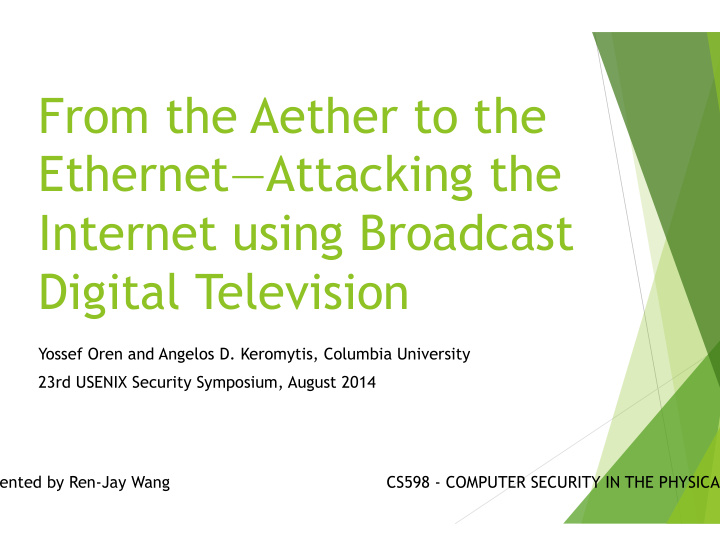



From the Aether to the Ethernet—Attacking the Internet using Broadcast Digital Television Yossef Oren and Angelos D. Keromytis, Columbia University 23rd USENIX Security Symposium, August 2014 esented by Ren-Jay Wang CS598 - COMPUTER SECURITY IN THE PHYSICAL
TV – Past Multiple data streams (MPEG-2 Elementary Streams) Information tables group these streams into an individual TV channel
TV – Present(HbbTV) Additional application information table (AIT) describing broadband-based application AIT can hold URL to web content, or an additional data stream can hold the relevant HTML files (<-vulnerable!)
Related work 2013 – Tews et al. showed that it is possible to tell what someone is watching by sniffing encrypted HbbTV traffic packets 2013 – Herfurt discovered that many German HbbTV providers abused the HbbTV capabilities by having them “phone home” periodically when the channel was on
HbbTV Security Weaknesses Same-Origin Policy is flawed because broadcast streams can define THEIR OWN web origins to ANY desired domain name
HbbTV Security Weaknesses (cont.) Untraceable attacks Invisible and unstoppable attacks
Threat Model – Who are we defending against? Man in the middle attack Attacker has a physical device with an omnidirectional antenna Device is level with targeted devices Attacker is using an amplifier Co-Channel interference – is this a reasonable assumption? Densely populated urban area with low power TV stations
Possible attacks u Intranet Request Forgery Distributed Denial of Service u Phishing/Social Engineering Unauthenticated Request Forgery u Exploit Distribution Authenticated Request Forgery
Demonstration of Attacks 2012 Smart TV No power amplifier or transmitter antenna – DVB modulator directly connected to TV’s antenna input Created applications that ran in background & took over TV screen
Risk Assessment Analysis $450 to setup, additional $50/hour per attack Can affect 10,000 hosts using a modest amplifier
Countermeasures Crowdsource detection of RF attacks Indicate to users when HTML content is being displayed … however this may be resisted by broadcasters Prevent broadcast-delivered HTML content from accessing the internet – applications that required Internet access would have to submit a URL Encryption and proxies ineffective Content signing would prevent same-origin abuse, but would still not be sufficient due to “blind” CSRF/PuppetNet attacks
Discussion Points Are the criticisms leveled against the paper valid? That is, can these attacks feasibly reach a large number of systems? Are they cost-effective? What are limitations to these attacks? What are the main contributions of this paper? What could be done to prevent these attacks?
More recommend